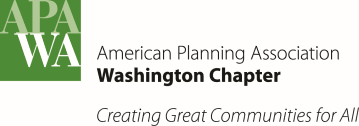- About Us
- Events & Training
- Professional Development
- Sponsorship
- Get Involved
- Resources
Bellingham showcases pedestrian and bicycle plan
By Chris Comeau, AICP CTP, Transportation Planner, Bellingham Public Works Engineering Bellingham transportation planners have now completed both a 2012 Pedestrian Master Plan and a 2014 Bicycle Master Plan to complement the citywide multimodal transportation planning work. Both plans are guided by community visions, goals, and policies that support healthy lifestyles and active transportation choices, as well as environmental and economic benefits derived from supporting non-motorized travel. Bellingham's Pedestrian and Bicycle Master Plans also support long-term mode shift goals adopted in the transportation element of the comprehensive plan, which serve as targets to reduce the percentage of total trips made by single-occupant vehicles while increasing the percentage of total trips made by pedestrians, bicyclists, and transit riders. According to the 2008-2012 American Community Survey (U.S. Census) data, Bellingham is well on the way to achieving its transportation mode shift goals for increasing non-automotive commutes to work while decreasing automotive commutes work:
The Pedestrian Master Plan defines a 135-mile sidewalk network, the Bicycle Master Plan defines a 170-mile bicycle network, and both are integrated with Bellingham’s 70-mile off-street Greenways multi-use trail network. Extensive community surveys were conducted for both of the plans to solicit responses from neighborhood residents, which resulted in a long list of pedestrian and bicycle improvement requests and concerns. Steering Committees were formed for each plan with broad representation from various community interest groups, including health professionals, to establish the guiding visions, goals, and policies and also to oversee and review the network analysis done by consultants and City transportation planners. Once the pedestrian and bicycle networks were defined, deficiencies and project improvements were identified and prioritized for short-, medium-, or long-term implementation with criteria weighted according to the goals of the plan.
Defining non-motorized transportation networks and creating plans that promote healthy lifestyles and active transportation choices constitute an important start, but without a commitment for implementation plans just become "shelf art" that gather dust without providing any measurable benefit to the community. The Pedestrian Master Plan includes a prioritized list of 343 sidewalk and intersection improvements and the Bicycle Master Plan includes a prioritized list of 181 bicycle facility projects. The estimated cost to complete these ambitious and long-term bicycle and pedestrian networks is over $270 million dollars, which is far in excess of Bellingham’s ability to construct with local funding alone. Fortunately, Bellingham has become increasingly successful at maximizing efficiencies and accomplishing multiple goals when committing funding to public infrastructure improvements. Repairing water and sewer utilities under arterial streets creates opportunities to add both bicycle and pedestrian improvements and, wherever possible, arterial street resurfacing projects always include the installation of bicycle lanes and ADA-compliant sidewalks and curb ramps. Bellingham has also been very successful at creating funding partnerships with the transit agency, universities, WSDOT, the County, and private developers to secure state and federal grant funds, which makes limited local funds go farther. Additionally, in 2010, Bellingham voters approved a Transportation Benefit District (TBD) funded by a two-tenths of one percent sales tax collected within the City limits of Bellingham with funding directed to arterial street resurfacing, non-motorized transportation improvements, and supplemental WTA transit service provided through a contract with the City. The TBD revenue is available for a 10-year period (2011-2020) and is greatly assisting Bellingham to complete the citywide pedestrian and bicycle networks identified in the Pedestrian and Bicycle Master Plans, to support WTA’s efforts to provide a robust urban transit system, and to help achieve and sustain the City’s long-term transportation mode-shift goals. Bellingham is already a great place to walk, bike, and enjoy healthy lifestyles and activities. Many neighborhoods are very walkable and are well-connected to community activity centers with sidewalks and multi-use recreational trails. Many destinations are also well-connected with bicycle lanes on arterial streets and Bellingham is certified as a silver-level "Bicycle Friendly Community" by the League of American Bicyclists. The completion and implementation of pedestrian and bicycle plans has set Bellingham on a path to become one of the most pedestrian- and bicycle-friendly communities in North America for people of all ages and abilities. You can hear more about Bellingham's multimodal transportation planning in presentations titled "Transforming an Auto-Oriented Transportation Legacy" (Oct 16, 2:00 pm) and "Transportation Transformation: Back to the Future" (Oct 17, 8:30 am) at APA Washington's "Legacy and Prophecy" Conference in Spokane, WA on October 16-17, 2014. Chris Comeau, AICP CTP is the City of Bellingham's transportation planner with more than 20 years of planning experience in Washington, Alaska, and Arizona. Chris is also currently serving as Secretary on the APA Washington Board of Directors (2013-2015) and he can be reached at [email protected] or (360) 778-7946 in the Bellingham Public Works Engineering Department. |
|||||||||||||||||||||||||||||


